Check your facts, AP
I am shocked at the rampant looting and carjacking occuring in the Big Easy. That's the last place I could ever imagine such lawless behavior.
Visors & Stovepipes
Did you see the ESPN GameDay season opener from South Carolina with the live performance by Big & Rich feat. Lil Troy? I did, unfortunately, and I feel violated. I'll elaborate later on the reasons for my disillusionment with ESPN, but it's time for a mutiny.
per Publius
There are no problems in this country that cannot be solved by a heaping spoonful of redneck patriotism.
Listerine Drunk
Hot: Taradise, Tara Reid's new show on E! I caught two episodes this weekend, and it totally rocks. Tara has put on some miles since we first fell in love with her as Bunny Lebowski in the 1998 hit The Big Lebowski.
Not: Galveston, Texas and Dodge Stratus cars. Sucks like OU, the both of them.
Not: Galveston, Texas and Dodge Stratus cars. Sucks like OU, the both of them.
Prunings IV
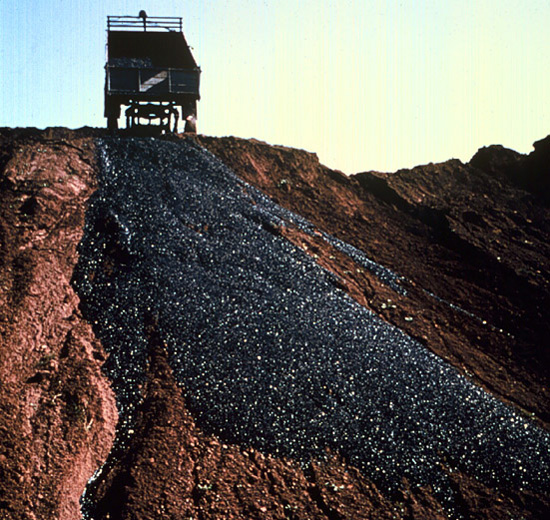
On Rundown (1969), Swamp (1969), and Spiral Jetty (1970), three itsy bitsy teenie weenie movies documenting Robert Smithson's land art.
On landscape design at Columbia University. Perhaps testing the waters with a goal towards creating an accredited landscape architecture program? Will Princeton, Yale, MIT, and other bastions of architectural education follow suit?
On walking as knowing as making.
On LEAM, i.e. Land Use Evolution and Impact Assessment Model.
On drinking water (a brief history).
On parking (another brief history).
On cemeteries. Because Pruned just cannot get enough of them.
Curtis's Botanical Magazine
Begun in 1787, Curtis's Botanical Magazine is still being published, making it the oldest periodical in existence featuring colored plates. Two sites host electronic facsimiles of the early volumes. The University of Georgia Libraries has the first 20 volumes (DjVu format) online in full color. And the National Agricultural Library has many images from the first 26 volumes. Introductory information can be found here.



University of Georgia Libraries
National Agricultural Library
Glasgow University Special Collections
Botanical Wunderkammer
Botanical Wunderkammer, Part II



University of Georgia Libraries
National Agricultural Library
Glasgow University Special Collections
Botanical Wunderkammer
Botanical Wunderkammer, Part II
Forever Fernwood, Part II
Tyler Cassity, the impresario behind Forever Fernwood and Hollywood Memorial Park, gets another portrait from this week's issue of The New Yorker, a much, much fleshier one than this recent article from The New York Times.

He is described as resembling Robert Downy, Jr. or a young J.F.K. with a voice that is “a velvety vibrato, like a leopard's purr,” which he no doubt used to devastating effect when he fired off his team of landscape architects, architects and ecologists that he had hired to develop Forever Fernwood into a prototype green cemetery.
“He stood there with this pleasant, smug little smile,” recalls one of the axed landscape architects.
Working for him must surely be aggravating but never uninteresting: “His assistant, Samantha Tibbs, has quit six times, and he likes hiring former sex workers and down-on-their-luck porn stars.” Could his mercurial temperament be a manifestation of latent family trauma? On two of his ancestors — one a Chinese girl and another a Cherokee — Cassity muses: “I'm assuming they were both raped.”
Of course, the article does devote a lot to the “green” cemetery movement wherein Tyler Cassity is arguably its most visible practitioner in the US. We also read how he and the unfortunate souls who happened to have crossed path with him want to bring sustainable burial practices out from its niche market to claim a bigger piece of the multi-billion dollar cemetery industry. Considering Cassity's Hollywood personality, however, that seems like a Promethean undertaking. Furthermore, he and his partners regularly go for long stretches of time without speaking to each other.
For what it's worth, you'll come away from reading the article knowing how to turn a tumbledown city of dead Hollywood moguls and superstars into a profitable venture. “Multi-purpose” is the key word. When Tyler Cassity bought the bankrupt Hollywood Memorial Park, whose famous residents include Rudolph Valentino and Cecil B DeMille, he started throwing parties, screened movies on the mausoleum, and basically turned it into an urban open space. That or you could always hire a starchitect.
The article is not available online but a Q&A between author Tad Friend and Amy Davidson is available. The two talk about green burials, graveyard tourism and the future of funerals.
Forever Fernwood
Forever Fernwood, Part III

He is described as resembling Robert Downy, Jr. or a young J.F.K. with a voice that is “a velvety vibrato, like a leopard's purr,” which he no doubt used to devastating effect when he fired off his team of landscape architects, architects and ecologists that he had hired to develop Forever Fernwood into a prototype green cemetery.
“He stood there with this pleasant, smug little smile,” recalls one of the axed landscape architects.
Working for him must surely be aggravating but never uninteresting: “His assistant, Samantha Tibbs, has quit six times, and he likes hiring former sex workers and down-on-their-luck porn stars.” Could his mercurial temperament be a manifestation of latent family trauma? On two of his ancestors — one a Chinese girl and another a Cherokee — Cassity muses: “I'm assuming they were both raped.”
Of course, the article does devote a lot to the “green” cemetery movement wherein Tyler Cassity is arguably its most visible practitioner in the US. We also read how he and the unfortunate souls who happened to have crossed path with him want to bring sustainable burial practices out from its niche market to claim a bigger piece of the multi-billion dollar cemetery industry. Considering Cassity's Hollywood personality, however, that seems like a Promethean undertaking. Furthermore, he and his partners regularly go for long stretches of time without speaking to each other.
For what it's worth, you'll come away from reading the article knowing how to turn a tumbledown city of dead Hollywood moguls and superstars into a profitable venture. “Multi-purpose” is the key word. When Tyler Cassity bought the bankrupt Hollywood Memorial Park, whose famous residents include Rudolph Valentino and Cecil B DeMille, he started throwing parties, screened movies on the mausoleum, and basically turned it into an urban open space. That or you could always hire a starchitect.
The article is not available online but a Q&A between author Tad Friend and Amy Davidson is available. The two talk about green burials, graveyard tourism and the future of funerals.
Forever Fernwood
Forever Fernwood, Part III
La Machine de Marly
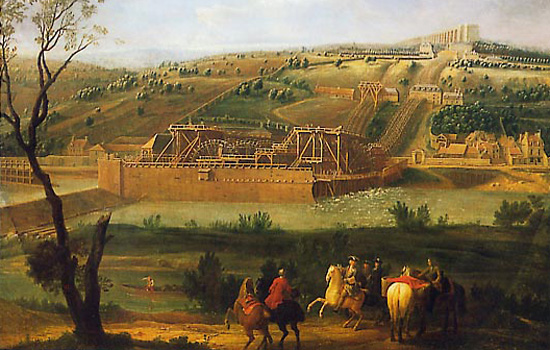
Some images of La Machine de Marly, the engineering marvel responsible for the gushing fountains and other water features at Versailles.
Fourteen paddlewheels, each about 30 feet in diameter, were turned by the Seine to power more than 200 pumps, forcing river water up a series of pipes to the Louveciennes aquaduct, a 500 foot vertical rise.
The original Louis XIV Machine included not just an enormous structure on the river itself, but sprawled all the way up the hill, comprising pumping stations, holding tanks, reservoirs, pipes and an intricate system of mechanical linkages to power pumps on the hill from the waterwheels below. Several accounts of the epoque describe the infernal noise this all generated, keeping Mme Dubarry (Louis XV's last mistress) and her guests awake in her nearby chateau. Sixty maintenance workers were employed to keep it running. Pumping at full capacity, it could add over a million gallons in 24 hours to the Marly reservoirs.
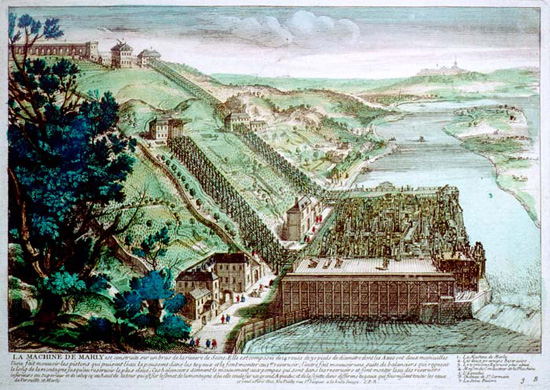
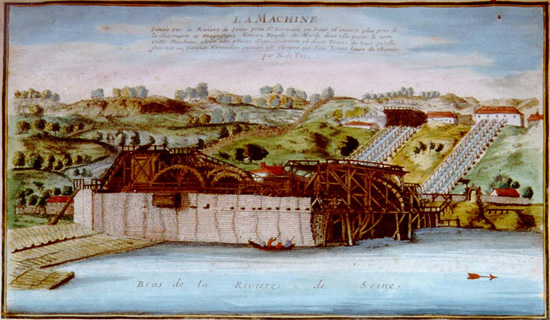
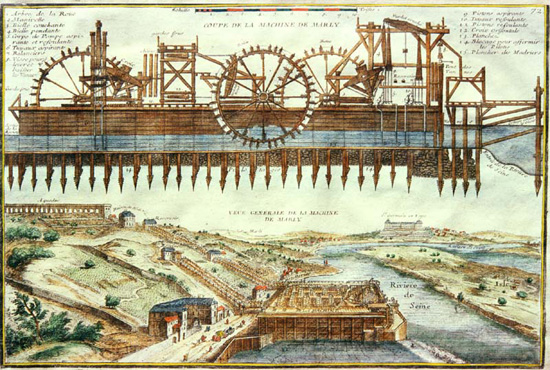
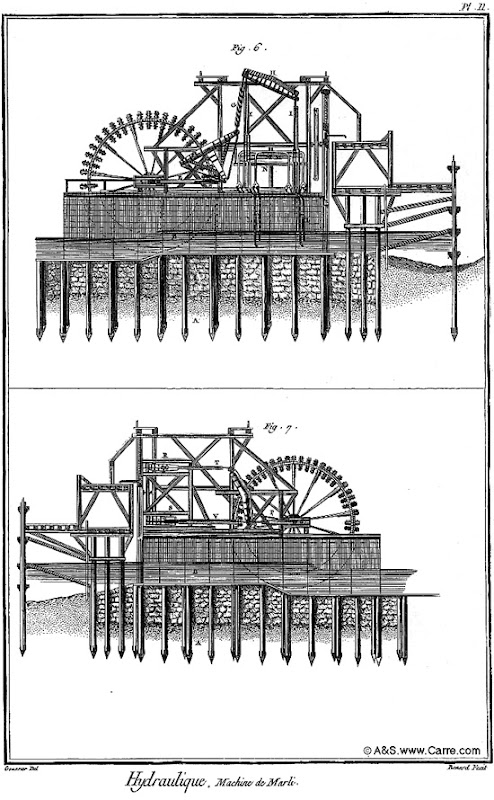
La Machine de Marly
The Marly Machine and its Builder: the Walloon Engineer Renkin Sualem
Chateau of Marly
Datafountain
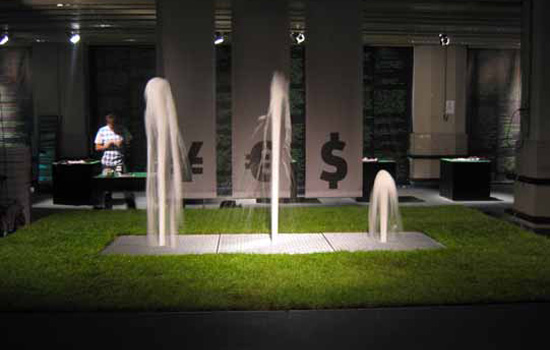
It is a story lectured to eager young students since time immemorial or since John Dixon Hunt began teaching (or whichever one is closest to the truth): when Louis XIV treated VIPs to a tour of his gardens at Versailles, the route they took was carefully choreographed, with a predetermined order of strolls, stops and contemplation, not unlike perhaps a self-guided, podcast-narrated educational garden tour, which you can do at Millennium Park Chicago. But the cause for enlightenment had nothing to do with the program.
Emperors and kings have long understood that any display of water control can give much needed political and social capital to their persons and rule. Who else would have had the resources to channel water far away from its source, almost always in defiance of gravity, and then to make it dance, fly, ripple, and even whistle a merry tune? Only the powerful and wealthy, of course. To put it in another way, fountains are perfect propaganda.
Unfortunately, Versailles was situated on a flat plain. To create the needed hydraulic pressure, water is typically outsourced from high elevations; gravity would then most of the work. So what alternative did they use? Engineering.
But still, the complex system of pumps, aqueducts, underground tunnels and pipe distribution was not enough at times. Hence the choreography: not all fountains in the gardens were turned on, just the ones where the royal coterie happens to be.
I was reminded of this when reading about Datafountain, a fountain in which currency fluctuations determine in realtime the height of the water and noise level. In effect, the frenetic pace and information overload of global capitalism get filtered and translated into a quiet, bubbling spring. Or not: when markets are their usual volatile selves, the fountain would be quite active both visually and aurally.
Curiously, it would probably be at its calmest when the yen, pound, and dollar plummet and become worthless. A world-ending catastrophe can do that.
What is equally intriguing about Datafountain is the possibility to connect it to other informationally-rich events, such as the weather, urban power consumption (how much electricity does a park or a forest preserve actually consume?) and traffic. So that pretty fountain in the office lobby will broadcast traffic conditions on highways and major arterial roads, thereby possibly helping you to decide which ones to take home. (It can also be a map, too.)
Of course, less benign events can be plugged-in as well: the daily casualty rates in Iraq and Afghanistan; the number of squatter houses bulldozed by African despots; the daily global death rates from AIDS (a fountain for each continent, perhaps). The possibilities are endless.
When we see a fountain in public space, we always wonder what its spraying pattern tells us. It is our future goal to design more contextual datafountains and also to re-think existing fountains as information displays. Perhaps in the future, it will be considered rude to place a fountain in public space that has nothing to say. The information displayed on the fountain will become part of a discussion about the design of public space. The context plays an important role in the communicational value; a fountain in front of a metro station will probably means something different than a fountain in front of a stock exchange.
Genius. Go see.
La Machine de Marly
Prunings III

My nibblings from the blogosphere.
On surrogate earths. And Brad Pitt. Alas, no Angelina. A bit about Jen and Val though. All are connoisseurs of filmic spaces (re: surrogate earths), I suppose. A treadmill is thrown in for good measure.
On Spiral Jetty as seen and described by E. What luck!
On the CTA.
On recycling receptacles, winners of a Chicago competition.
On some shitty landscaping. Landscape architecture just cannot get any respect.
On haute couture... on Mistress Zaha... on a bad day. Oh, dear.
On how much a tree is worth.
Smell the Roses
For my money, there's nothing more honest and refreshing than talking loudly on your cellphone in a crowded elevator.
Landscape Architecture Merit Badge
After reading an article on three scouts receiving a Landscape Architecture Merit Badge [pdf], I decided to investigate the requirements. It seems that the process is quite involved, hardly casual. The first on the list is as follows:
 How does one answer this without being overcomed by existential angst or mired in the politics over professional boundaries? In several states, lobbyists for civil engineering and architecture associations (and others, for sure) are always weary, if not hostile, over state licensure legislations for landscape architects, since these legislations typically list the types of activities that only licensed landscape architects may then only perform. Should road design fall under the purview of landscape architects or civil engineers? So perhaps merit badge recipients will come away with a defining landscape architectural trait: schizophrenia.
How does one answer this without being overcomed by existential angst or mired in the politics over professional boundaries? In several states, lobbyists for civil engineering and architecture associations (and others, for sure) are always weary, if not hostile, over state licensure legislations for landscape architects, since these legislations typically list the types of activities that only licensed landscape architects may then only perform. Should road design fall under the purview of landscape architects or civil engineers? So perhaps merit badge recipients will come away with a defining landscape architectural trait: schizophrenia.
Other tasks sound like introductory assignments at any landscape architecture program.
Would a cemetery count as a place of worship?
It is all approved by the ASLA, so perhaps a merit badge should qualify one for some college credit or substitute for an entire semester.
Explain the differences between a landscape architect and a horticulturist, a landscape contractor, an architect, an urban planner, and a civil engineer. Give an example of the work each might do that is unique to that vocation. How might people in these positions work with a landscape architect?
 How does one answer this without being overcomed by existential angst or mired in the politics over professional boundaries? In several states, lobbyists for civil engineering and architecture associations (and others, for sure) are always weary, if not hostile, over state licensure legislations for landscape architects, since these legislations typically list the types of activities that only licensed landscape architects may then only perform. Should road design fall under the purview of landscape architects or civil engineers? So perhaps merit badge recipients will come away with a defining landscape architectural trait: schizophrenia.
How does one answer this without being overcomed by existential angst or mired in the politics over professional boundaries? In several states, lobbyists for civil engineering and architecture associations (and others, for sure) are always weary, if not hostile, over state licensure legislations for landscape architects, since these legislations typically list the types of activities that only licensed landscape architects may then only perform. Should road design fall under the purview of landscape architects or civil engineers? So perhaps merit badge recipients will come away with a defining landscape architectural trait: schizophrenia.Other tasks sound like introductory assignments at any landscape architecture program.
Look at and study a place of worship or school grounds to find the place where most people arrive by bus or car. Show you can do the following:
A) Using a measuring tape, measure and draw the entry and its nearby area using a scale of 1/8 inch equal to 1 foot on an 11-by-17-inch piece of paper. Be sure to include the driveway and the wall and door where people enter the school or place of worship. Indicate any sidewalks, structures, trees, and plants within the study area. Make a copy of this plan to save the original. Do the next two items on copies.
B) On one copy, use directional arrows to indicate where the water drains across the site, where ditches occur, and where water stands for a longer period of time.
C) Decide on how you can make the place safer and more comfortable for those using it. Redesign the area on another copy
of the plan. You may want to include new walks, covered waiting areas, benches, space-defining plantings of trees and
shrubs, and drainage structures.
Would a cemetery count as a place of worship?
It is all approved by the ASLA, so perhaps a merit badge should qualify one for some college credit or substitute for an entire semester.
Massimo Vitali: Photographs 1995-2005
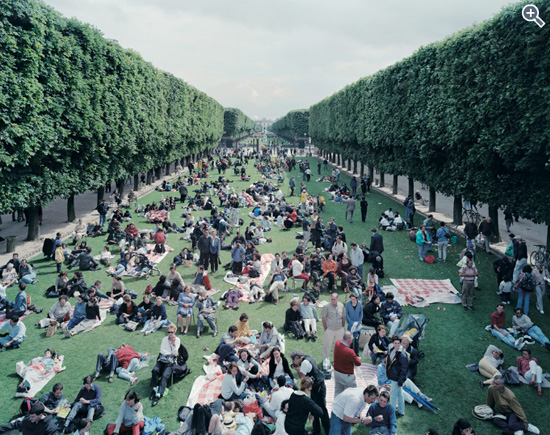
Massimo Vitali is known for photographing crowded landscapes of leisure, of play, of the good life as acted out by Westerners, but these crowded spaces are disquieting, almost menacing. There's a certain familiarity to the photographs. They seem like documentation of built works, successful projects at that for they are actually filled with people doing what these spaces were designed to accommodate. (How often have we seen images of built works completely devoid of their intended user, i.e. raison d'être, as if they were never meant to be inhabited?)
Yet Vitali's landscapes seem quite close to complete systematic failure. One or two more skiers and perhaps an avalanche might be triggered. One more family of sunbathers at the beach and a riot might ensue over sand and sky; there can be too little of them I suppose. Add one more reveler to the concert hall and voila, structural collapse. I've always thought that just a single person can ruin my view down an allée. What's an allée for if a picnicking couple blocks your view towards infinity?
Now here's a studio problem: how would one design a landscape intended for critical failure? One designs to cope with 100-year floods. But how do you program a (public?) space that's open to catastrophic structural breakdown (without killing people, of course)?
Massimo Vitali: Photographs 1995-2005 runs through 8 October 2005 at Lentos Art Museum in Linz, Austria.
Friendly Reminder
Hey gang, don't forget to file bankruptcy before October 17! If you dilly-dally, changes in bankruptcy law will make erasing debts more difficult.
Why are you wearing sunglasses in your office?
This time I mean it. I'm not going out with Pacman Jones and the fellas on a school night ever again.
Forever Fernwood
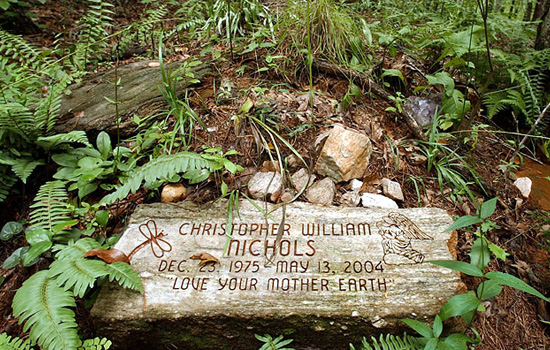
The New York Times today gives us a tour of the newly opened section of Forever Fernwood, a cemetery located just north of San Francisco in Mill Valley, California, where people can get a “natural burial.”
In reading about the first inhabitant, we learn what this actually entails:
He was buried un-embalmed in a biodegradable pine coffin painted with daisies and rainbows, his soul marked by prairie grasses instead of a granite colossus.
Here, where redwood forests and quivering wildflower meadows replace fountains and manicured lawns, graves are not merely graves. They are ecosystems in which 'each person is replanted, becoming a little seed bank,' said Tyler Cassity, a 35-year-old entrepreneur who reopened the long-moldering cemetery last fall.
It's surprising to see so few (none really) prominent landscape architecture firms involved in cemetery design, when academia is practically obsessed with them. Each semester never fails to involve a field trip to a cemetery or two, and no landscape history course can forgo mentioning Mt. Auburn, Woodlawn, or Brion. In fact, what most consider the first masterpiece of landscape architecture, the Temple of Hatshepsut, is a funerary site. Every student does a cemetery project; it's a rite of passage.
Cemeteries, like gardens and parks, are enclosed systems. Despite being deeply ingrained in the local culture and beliefs, contemporary practices nevertheless situate them spatially away from everyday experiences. As such they offer opportunities for experimentation, ideal for new methods and practices that may prove to have broader influence and application. Mt. Auburn Cemetery certainly can attest to this. So if your firm is in a state of stylistic recursion, perhaps you should dable in a cemetery project for a month or two to try and get yourself out of your rut.
Imagine all the fuss and conflicts working in cemetery design would generate: between forms and processes that continue the American experience of burial (detached, fast, and antiseptic) and those that would closely resemble a Varanasi funerary ritual (intensely sensory); between the practical concerns of a multi-billion dollar industry and artistic concerns; and between issues of sustainability and the popular image of cemeteries with perfect green lawns. So by the time you finish, you could find yourself stimulated again, brimming over with creative energy.
And so I await to see more landscape architects position themselves in cemetery design and hear what comes of it.
Curmudgeon of the Month
Nature is dead. Long live Nature.
Forever Fernwood, Part II
Forever Fernwood, Part III
Prunings II

On smart forests.
On the International Carlo Scarpa Prize for Gardens. There is such a thing? This year's prize, which is given by Fondazione Benetton Studi Ricerche, went to Deir Abu Maqar, a Coptic monastery in Egypt.
On the morality of maps.
On some free journal articles here and here. The latter will drive you mad.
On the vernacular in twenty-nine photographs.
On a favorite subject.
On something mobile, temporary and otherwise.
Where would you rather live?
This blog entry calls for audience participation. Please post your city choices and commentary. Remember, you're moving there, not just visiting, so choose wisely.
Sao Paulo or Dubrovnik?
Havana or Shanghai?
Cairo or Moscow?
Dallas or Nashville?
Honolulu or Boulder?
Helsinki or Athens?
Addis Ababa, Ethiopia or Kiev, Ukraine?
Tegucigalpa, Honduras or Dubai, UAE?
Buenos Aires or Cape Town?
London or New York?
Terlingua or Anchorage?
Knoxville or Phoenix?
Montreal or Mexico City?
Bombay or Beijing?
Rio de Janeiro or Brussels?
Saigon or Tokyo?
Manila, The Philippines or Nairobi, Kenya?
Bermuda or Taos?
Houston or Seattle?
Sydney or New Orleans?
Miami or Barcelona?
Geneva or Cancun?
Paris or Washington, D.C.?
Las Vegas or San Diego?
Detroit or Shreveport?
Aspen or Atlanta?
Hong Kong or Prague?
Vancouver or Chicago?
Odessa or Laredo?
Teheran, Iran or Lagos, Nigeria?
Singapore or Copenhagen?
Omaha or Caracas?
Vienna or St. John, USVI?
Istanbul or Bangkok?
Auckland or Dublin?
Boston or Reno?
Calcutta, India or Alma Aty, Kazakhstan?
Seoul or Bogotá?
Winnipeg or Bilbao, Spain?
Ibiza or Stockholm?
Sao Paulo or Dubrovnik?
Havana or Shanghai?
Cairo or Moscow?
Dallas or Nashville?
Honolulu or Boulder?
Helsinki or Athens?
Addis Ababa, Ethiopia or Kiev, Ukraine?
Tegucigalpa, Honduras or Dubai, UAE?
Buenos Aires or Cape Town?
London or New York?
Terlingua or Anchorage?
Knoxville or Phoenix?
Montreal or Mexico City?
Bombay or Beijing?
Rio de Janeiro or Brussels?
Saigon or Tokyo?
Manila, The Philippines or Nairobi, Kenya?
Bermuda or Taos?
Houston or Seattle?
Sydney or New Orleans?
Miami or Barcelona?
Geneva or Cancun?
Paris or Washington, D.C.?
Las Vegas or San Diego?
Detroit or Shreveport?
Aspen or Atlanta?
Hong Kong or Prague?
Vancouver or Chicago?
Odessa or Laredo?
Teheran, Iran or Lagos, Nigeria?
Singapore or Copenhagen?
Omaha or Caracas?
Vienna or St. John, USVI?
Istanbul or Bangkok?
Auckland or Dublin?
Boston or Reno?
Calcutta, India or Alma Aty, Kazakhstan?
Seoul or Bogotá?
Winnipeg or Bilbao, Spain?
Ibiza or Stockholm?
Ultra-hip and underground
I'm nowhere to be found in August's edition of 002+ magazine. Obviously, I'm not partying nearly aggressively enough.
Slice

To compensate for the lack of entries on purely architectural matters, I offer Slice, which may or may not be purely about architecture. Self-described as the unofficial satirical journal of SOA life, it existed for only a few but intensely hilarious issues. Unfortunately, only one exists online. Or are the rest out there?
War Gardening and Home Storage of Vegetables (1919)

“Dear Sirs: The War Department finds much satisfaction in the creation of War Gardens at various army camps by the Conservation and Reclamation Division of the Quartermaster General's office. Food production at these camps has been the subject of some concert with the department. The large areas of tillable land within many of the military reservations have been regarded as offering potential food production on a large scale, and I feel that the army is to be congratulated that the utilization of this space has now taken concrete form.” — Newton D. Baker, Secretary of War
“How's the weather?”

From Diller + Scofidio, Blur: The Making of Nothing (2002):
When we speak about weather, it's assumed that more meaningful forms of communication are being avoided. But is not the weather, in fact, a potent topic of cultural exchange - a bond that cuts through social distinction and economic class, that supersedes geological borders? Is not the weather the only truly tangible and meaningful thread that glues us all together? Is not the weather the only truly global issue? In truth, contemporary culture is addicted to weather information. We watch, read, and listen to weather reports across every medium of communication, from conventional print to real-time satellite images and Web cams. The weather channel provides round-the-clock, real-time meteorological entertainment. Boredom is key. But boredom turns to melodrama when something out of the ordinary happens. Major weather events are structured like narrative dramas with anticipation heightened by detection and tracking, leading to the climax of real-time impact, capped by the aftermath of devastation or heroic survival.
Since the first hurricane of the season, I have been an avid viewer of The Weather Channel, not as addicted as one may be to a reality show but my viewing pattern goes far, far beyond merely checking the day's high and low temperatures. I have followed Hurricane Arlene from early in its life in the Atlantic to its tattered remains in the Ohio River Valley. When Hurricane Emily plowed through the Yucatan, I wondered who will save the German tourists. I keep a scorecard of which Midwestern city holds the record for the least amount of rainfall in the current drought; Chicago is high on the list. In fact, the entire state of Illinois has been declared a disaster area. So how are the non-drought-resistence non-native non-prairie plant species in your lawn/garden/park faring? And what about the Crown Fountain and Cloud Gate in Millennium Park? While NOAA is raising the 2005 Atlantic hurricane season outlook, Tropical Depression Irene is brewing along nicely. I will, of course, keep a watch.
MILF

Introducing a new (irregular) sidebar feature, MILF: Landscape Architecture Film Series. In college I helped coordinate a film series with a different landscape theme each semester. Usually, whittling down the roster meant eliminating a lot of titles. MILF is my opportunity to resurrect those titles in an admittedly inconsequential format as it involves no viewing time and location. Simply take them as recommendations. Watch them anywhere and at anytime, in sequence, reversed or mixed, in part or in whole, in combination of future series or see one and no more ever again. You get the idea.
MILF:01 Figures in the Field
MILF:02 Spatializing the Marvelous: The Musicals of Busby Berkeley
MILF:03 Nanoscapes
MILF:04 The World
MILF:05 “The Best Things In Life Are Free”: Selections of Feature Films from the Internet Archive
MILF:06 Thick City
MILF:01 Figures in the Field
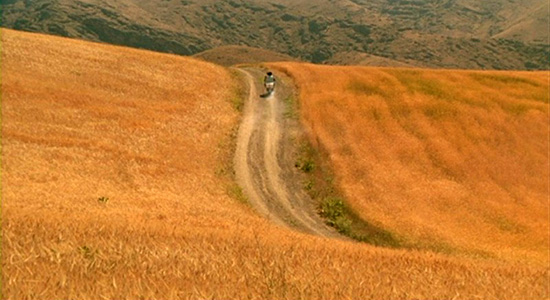
Greed (dir. Erich von Stroheim, 1924)
Miner-turned-dentist John McTeague could have been happily married if it were not for his wife winning the lottery, but of course, the money paves the way for their downfall with a desultory climax in Death Valley.
Playtime (dir. Jacques Tati, 1967)
Monsieur Hulot fumbles his way through modern Parisian architecture, landscape, and leather furniture.
Aguirre: The Wrath of the God (dir. Werner Herzog, 1972)
The search for the mythical El Dorado in the jungles of South America degenerates into a nightmare.
My Own Private Idaho (dir. Gus van Sant, 1991)
Two hustlers try to survive in the Pacific Northwest. While one is searching for his family, the other is fleeing his.
The Thin Red Line (dir. Terrence Malick, 1998)
Guadalcanal provides the setting for one of the most poetic films of the 90s.
The Wind Will Carry Us (dir. Abbas Kiarostami, 1999)
A media “engineer” from Tehran travels to northern Iran to document the funeral rites for an old woman. But she hasn't died yet, and so must wait and find something to occupy his time around the village.
MILF
MILF:02 Spatializing the Marvelous: The Musicals of Busby Berkeley
MILF:03 Nanoscapes
MILF:04 The World
MILF:05 “The Best Things In Life Are Free”: Selections of Feature Films from the Internet Archive
MILF:06 Thick City
Columbus Circle
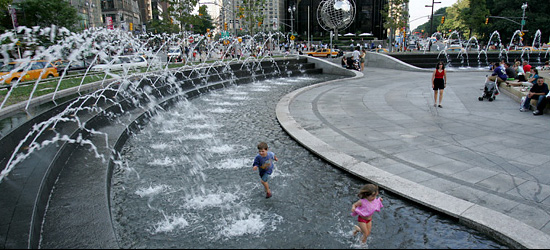
Last week the New York Times pre-pre-reviewed the redesigned Columbus Circle located just off of one corner of Central Park. The design is of the garden variety but has this intriguing byproduct:
The new Columbus Circle gives New Yorkers the chance to understand a critical element of the future World Trade Center memorial: how the sound of water can muffle distracting urban noise.
At the trade center memorial, cascading water walls will surround each of the voids that are to mark the absence of the twin towers. The Columbus Circle fountain begins to suggest how important sound will be. “I've always tried to impress upon people that it's a sensory experience,” said the architect Michael Arad, who won the memorial design competition in 2004 with Peter Walker & Partners.
Prunings I
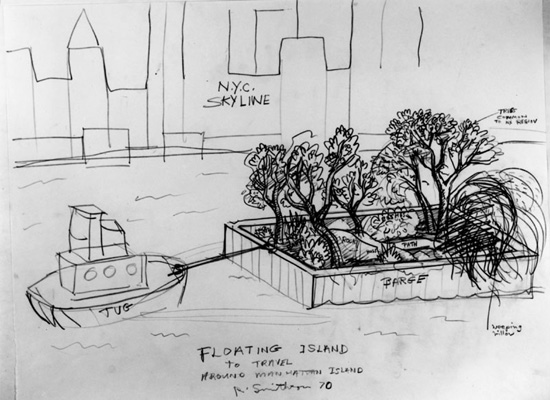
On B, i.e. bang.
On race, class, and the public administration of the built environment.
On subverting gated communities and parks by Heavy Trash.
On “delettering” public space.
On shaded relief maps, high resolution aerial photography, street maps, and a whole lot more. (But services are not fully free. A severe shortcoming.)
On a forgotten park. Presumably no more.
On Robert Smithson. No, not Whitney. Minetta Brook.
Al-Azhar Park, Cairo, Egypt
Tucked within the bland press junket website for the inauguration of Al-Azhar Park in Cairo, Egypt are several PDF files documenting the project from concept to built reality. Also documented is the wider conservation and urban revitalization plan for Darm al-Ahmar, the historic neighborhood where the park is situated. No doubt great resources for designers and preservationists. The juxtaposition of the park as a barren earthwork in the beginning and as a lush oasis amidst a dense urban environment is quite startling and marvelous.

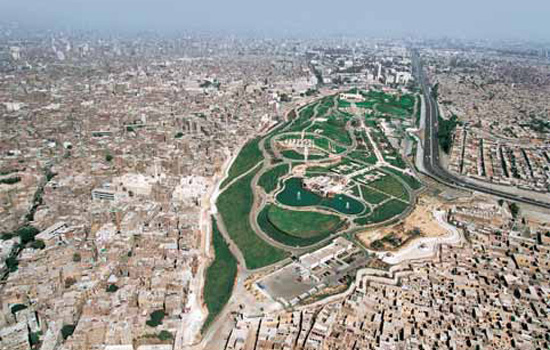
But let's see how the park matures and enter into the daily fabric of the city. For now, the photos reveal a park devoid of people or the multitude of activities it was designed for, which seem to have a decidedly Western flavor. Time, “the crucial dimension of landscape,” will only tell.


But let's see how the park matures and enter into the daily fabric of the city. For now, the photos reveal a park devoid of people or the multitude of activities it was designed for, which seem to have a decidedly Western flavor. Time, “the crucial dimension of landscape,” will only tell.
Red Carpet II
Have you seen Seann William Scott's portrayal of Bo Duke in The Dukes of Hazzard? Well, I haven't, but I can only assume it is one of the greatest theatrical performances of all time.
One Red Cent for Tribute
As you know, luridtransom is a Tara Reid Tribute Blog. Tara's beauty, sass and spark give us our one and only reason to get out of bed in the morning. In the spirit of tribute, I'm proud to promote Wild on Tara, Tara's new show on E!. The premiere is August 10th, and a source close to Tara says luridtransom faves Paris Latsis and Paris Hilton will make an appearance on the first episode. Be sure to tune in, I promise you won't want to miss it. In case you were wondering, the show's slogan is: "She's Improving World Relations...One Party at a Time!"
Rome and Nolli
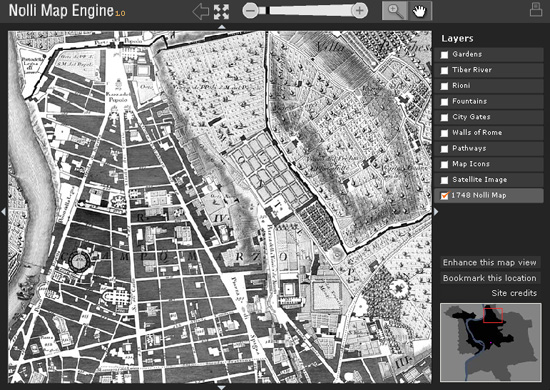
The Interactive Nolli Map Website is by far my personal favorite amongst the sites I have discovered through other blogs.
“The 1748 Nolli map of Rome, regarded by scholars and cartographers as one of the most important historical documents of the city, serves to geo-reference a vast body of information to better understand the Eternal City and its key role in shaping Western Civilization. The Nolli Map Web Site introduces students to Rome and the structure of its urban form; it illustrates the evolution of the city over time; and it reveals diverse factors that determined its development. Above all the Nolli Web Site is intended to provide a vehicle for students and teachers around the world to explore and facilitate creative thought.”
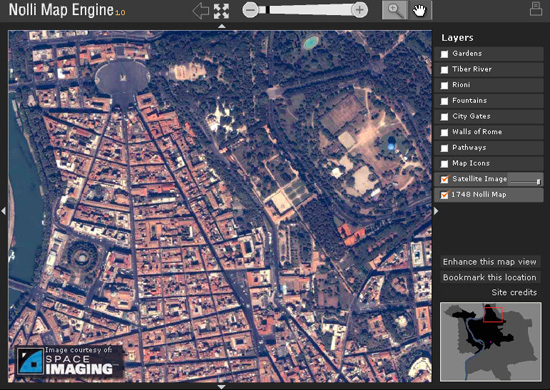
Besides illustrating the relationship between Roman buildings and public space, the Nolli map is intriguing in the way it reveals the city's highly choreographed built environment beneath a seemingly irrational city planning. Fascinating, too, is the depiction of villas and their formal gardens inside and outside the walls. There is much to play around with and many interesting read.
Book of the Hunt by Gaston Phoebus

After all the amazing discoveries in the online archives of the Library of Congress, I decided to see what other national libraries have to offer online. The first to be explored is the Bibliothèque nationale de France. Sure enough, after clicking and clicking for what seemed like an eternity, I found myself at a site featuring all 87 miniatures from Book of the Hunt (15th c.) by Gaston Phoebus. The miniatures depict aspects of hunting from the different types of game to methods of the hunt and to the care of hunting dogs in a landscape setting where men are as tall as trees and every landform resembles Pride Rock. Go see.
Supplements under the gun...
The recent outing of Rafael Palmiero as a steroid user has intensified the media critism of the supplement market which is something I've predicted here and in other places for a long time.
The claims they are making are not true, but they provide good media run nonetheless:
Whuaaa?
DHEA is hardly a popular muscle building supplement. It's effectiveness in bodybuilding has been widely disputed. Where DHEA IS most effective is for senior citizens in their fight against muscle wasting.
Never mind the following:
Palmiero tested positive for Stanazolol. which is not found in dietary supplements, except by those 'outside of the mainstream' companies.
Yes, there have been instances of supplements containing banned substances, but once that fact is known, the industry has done a good job of pulling those products off the market.
We need a true, honest debate about supplements in America, not media hype and half-truth's designed to prop up Big Pharm.
The lack of regulation and testing of nutritional supplements lends credence to the claims of players who say they were caught unaware by positive tests, one researcher said Tuesday.
The claims they are making are not true, but they provide good media run nonetheless:
Steroid building blocks known as prohormones can cause a positive test - and may not be listed on supplement labels, said Anthony C. Tommasello, a professor and director of the Office of Substance Abuse Studies at the University of Maryland pharmacy school in Baltimore.
"Some are extracts of natural products that are also metabolized into anabolic hormones but the substances are not on the banned list," Tommasello said.
One such ingredient is DHEA, Tommasello said. Mostly manufactured in China from the dried roots of a wild yam, it is a popular muscle-building supplement in the United States. While not on Major League Baseball's list of banned substances, it is converted in the body into an anabolic steroid, Tommasello said.
Whuaaa?
DHEA is hardly a popular muscle building supplement. It's effectiveness in bodybuilding has been widely disputed. Where DHEA IS most effective is for senior citizens in their fight against muscle wasting.
Never mind the following:
Palmiero tested positive for Stanazolol. which is not found in dietary supplements, except by those 'outside of the mainstream' companies.
Rafael Palmeiro's positive steroid test was for stanozolol, a powerful anabolic steroid that is not available in dietary supplements, according to a newspaper report.
The New York Times, citing a person in baseball with direct knowledge of the sport's drug-testing program, reported on its Web site Tuesday that Palmeiro tested positive for the drug known by the brand name Winstrol, most notably linked to the Olympic sprinter Ben Johnson of Canada.
The person who said that Palmeiro tested positive for stanozolol did not want to be identified because the testing policy prohibits anyone in baseball from disclosing information about test results without authorization, the Times said.
Yes, there have been instances of supplements containing banned substances, but once that fact is known, the industry has done a good job of pulling those products off the market.
We need a true, honest debate about supplements in America, not media hype and half-truth's designed to prop up Big Pharm.
Would you like to leave a message, Mr. Daly?
Cancel my appointments and hold all my calls, I'll be watching Laguna Beach: Season One on DVD all week long.
A Fortiori
Inshore fishing:Offshore fishing::American football:English football
To clear up the confusion, the term offshore fishing should be replaced by the term offshore soccer.
To clear up the confusion, the term offshore fishing should be replaced by the term offshore soccer.
Subscribe to:
Posts (Atom)
